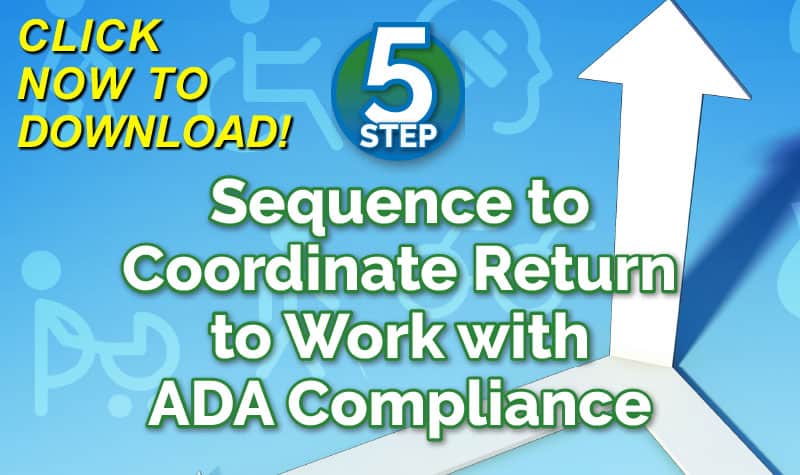The Federal Employees’ Compensation Act (FECA) provides benefits to all federal employees of the United States Government. These civilian employees of the U.S. government include the Departments of Agriculture, Commerce, Defense, Education, Health & Human, Services, Homeland Security, HUD, Justice, Interior, Labor, State, Transportation, Treasury, Veteran’s Affairs, Federal Judiciary (Court System), U.S. Postal Service, U.S. Capitol Police, Legislative Branch, TSA, NASA, Forest Service, Border Patrol, National Guard, et al.
Click Link to Access Free PDF Download
“5-Step Sequence to Coordinate Return-to-Work with ADA Compliance”
FECA is administered by the Office of Workers’ Compensation Programs (OWCP), U.S. Department of Labor, with 12 District Offices located across the United States. FECA is financed by the Employees’ Compensation Fund, appropriated by Congress directly and indirectly through a chargeback system.
FECA can be found on the U.S. Department of Labor, Employment Standards Administration, Office of Workers’ Compensation Programs website, http://www.dol.gov/esa/owcp_org.htm or at http://reduceyourworkerscomp.com/workers-compensation-laws-and-regulations-federal.php and by reviewing “The Federal Employee’s Compensation Procedure Manual,” and the 20 Code of Federal Regulations (C.F.R.) Part 700 to 799.
FECA’s law provides payment of benefits, including loss wage compensation, schedule awards, medical benefits, and vocational rehabilitation services for employment-related injuries and occupational disease sustained in the performance of duty by civilian employees.
FECA also provides payment of monetary compensation to specified survivors of an employee whose death resulted in a work-related injury with payments of certain burial expenses subject to the provisions of 5 U.S.C. § 8134. FECA, however, is not a retirement system.
FECA, passed in 1916, is remedial in nature and non-adversarial. It is the sole remedy since a federal employee or surviving dependent is not entitled to sue the U.S. Federal Government or recover damages for injury or death under any other law.
There are four (4) types of claims: 1. Traumatic Injury 2. Occupational Disease/Illness 3. Recurrences 4. Death
Five (5) Conditions of Coverage must be met: 1. Time 2. Civilian Employee 3. Fact of injury 4. Performance of Duty 5. Causal Relationship
The employee is responsible for establishing the essential elements of the claim. Office of Workers’ Compensation Program (OWCP) will help the employee to meet this responsibility, termed “burden of proof,” by requesting evidence needed to establish these elements if such information is not included with the original submittal. This assistance does not relieve the employee of his or her burden of proof. Agencies are required by law to provide medical and factual evidence requested by OWCP to adjudicate a claim. To minimize delays in the adjudication of claims, OWCP gives the employee and agency a specific period to submit required evidence in claim.
One of the biggest challenges facing federal employers under the FECA is reemployment when medical evidence shows disability has ended. Agencies are encouraged to reemploy, regardless of how long the injured worker (IW) has received compensation. The IW is expected to return eventually to work within medical restrictions when light duty is offered, pending full recover. If residuals of the injury prohibit the IW from returning to the position held at the time of injury, and IW has received compensation for more than one year, agencies can return IW to (1) the position held at time of injury with modifications to accommodate the IW’s limitations; (2) employment in another position at the same salary as the position held at time of injury; or, (3) employment in another position at a lower salary than the position held at the time of injury. If any loss of wages incur due to return to work in lower position, OWCP compensates the difference in pay.
One of the many services FECA provides is vocational rehabilitation services to assist IW in returning to gainful employment. One such service is “Assisted Reemployment.” OWCP may reimburse an employer who was not the employer at the time of injury for part of the salary of the reemployed IW. This wage subsidy is intended to assist in reemploying workers who are found to be difficult to place with their former employers. It is also available to other Federal employers as well as to State and local governments and the private sector. (workersxzcompxzkit)
Federal agencies continue to partnership with local government and the private sector to accomplish this agreement within agencies and do the right thing by working together as a community to reemploy those who are not totally disabled, by Protecting Our Workers and Ensuring Reemployment.
WorkCompRoundup Blog welcomes our newest guest writer, Sue Wetherington…
Author: Sue Wetherington has served as President and CEO of GS&S and Associates, Inc., St. Augustine, Florida since September 1999. GS&S, founded in 1999, is comprised of experts with over 120 years of combined experience with all laws and regulations governing workers’ compensation for federal employees and helps control escalating program costs and assist in returning injured workers to productive employment. Services include but are not limited to Workers’ Compensation Program diagnostics, roll reduction, development of automated claims filing and tracking systems, and formulation of policy letters and job offers. Contact her at sue@gss-compsolutions.com; gss-compsolutions.com. Or (904) 461-5520
We accept articles about WC cost containment. Contact us at: Info@WorkersCompKit.com.
Do not use this information without independent verification. All state laws vary. You should consult with your insurance broker or agent about workers’ comp issues.
©2009 Amaxx Risk Solutions, Inc. All rights reserved under International Copyright Law. If you would like permission to reprint this material, contact Info@WorkersCompKit.com.



